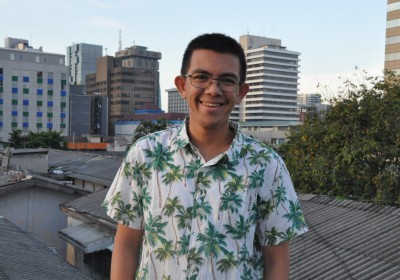Selected Speaker for IDF 2019: Franseco Hugo Proposes the Concept of Food Production Zone
November 12, 2019
Franseco Hugo
“Agriculture needs to be planned so that production is sufficient for consumption. This can be arranged through the production zone system,” said Selected Speaker for IDF 2019, Franseco Hugo.
In his presentation entitled “Production Zone (NaSi)”, Hugo explained that food provision planning is done based on the development of regions that produce food ingredients, such as agriculture, plantation, gardening, inland fisheries, and marine fisheries. Agricultural production regions are listed, from Aceh to Papua.
“NaSi is an agricultural zone equivalent to sub-district or district level, whose area is determined according to the actual condition of food producers in each zone,” said Franseco, who is a member of Indonesian Anthropology Association.
Hugo graduated from the Anthropology major at Padjadjaran University and was once the Social and Cultural Expert at the Regional Infrastructure Development Agency of the Ministry of Public Works and People’s Housing (Kemen PUPR). The idea for NaSi was born during his time there. At the time, Hugo handled zoning, which divided Indonesia into several Strategic Development Zones (WPS), including the outermost islands.
“I am trying to follow that example, but focusing more on agriculture,” he explained.
The initial phase of the agricultural production zone can be focused on meeting primary food needs.
The Need for Sound Mapping
NaSi will be classified based on unique landscape conditions and the potential of the zone. In this case, it is necessary to form a survey and research team that will develop a summary of suitable plant types and the number of population, along with their characteristics in each zone. This team will then collect the number of people who need production yielded from NaSi. So, the production deficit in each zone will be covered by excess from another zone.
“This is where identification and sound mapping take center stage. Each NaSi zone can form an agency and have an application connected with NaSi across Indonesia,” he continued.
Data will be recorded in the application, and communication can also be done on the same platform. The difference in each zone will be recorded and planned so that it can be covered from other zones.
“For example, NaSi 1 is lacking sago and NaSi 30 has an excess of it. NaSi 30 can then send some of it to NaSi 1. The best way is to take it from the closest NaSi zone to make the logistic cost cheaper,” Hugo explained.
The remaining production that is not distributed to other NaSi will be sold to the market, from marketplaces to restaurants or Healthy Cafeterias. These healthy cafeterias are tasked with promoting and giving health-related prevention efforts in providing low-cost food according to health standards.
“The primary objective of NaSi is to meet consumption, and hopefully, with sound mapping and well-recorded data, we will know if we need to increase production to meet consumption. In the long run, this will also reduce import,” Hugo continued.
According to Hugo, NaSi will be able to meet the basic food needs of Indonesian people with healthy and nutritious food.
Driving Employment Opportunities
How can NaSi drive skills and employment opportunities? With good data recording, in rural areas NaSi will promote the provision of new lands and agricultural equipment to support the production of basic food needs. These lands will be managed by trained young workers recruited from each sub-district/kelurahan.
“In urban areas, NaSi will develop urban farming in the form of vertical agriculture or indoor agriculture, filled with vegetables and medicinal plants,” he added.
In urban areas, NaSi can be managed by young workers recruited from every district-kelurahan, by giving them training. NaSi workers, both in villages and cities, will be given wages above the Regional Minimum Wage (UMR), complete with health insurance, their share of daily food ingredients, and workers’ apartment. Workers will be organised through the worker union in each NaSi in their respective zones.
Hugo presented the NaSi concept during the Ideas and Innovations, Marketplace Co-Creating and Collaborating session on July 22, 2019. This presentation is included in Subtheme-3: Creating Inclusive Employment Opportunities, which is a part of IDF 2019’s main theme, “Mission Possible: Seizing the Opportunities for Future Work to Drive Inclusive Growth.”
Indonesia’s Research Institutions Supporting the Development of the Electric Vehicle Industry
Indonesian Muslim Fashion and Cosmetics IKMs Shine at Dubai World Expo 2020
Govt Steps Up UMKM Transformation Efforts in the Midst of Pandemic Slowdown
Govt Encourages Promotion of IKM Products in Digital Era
Government Begins Developing Maritime Training Center in Makassar
Tweets by IDDevForum
